| NONTRADITIONAL |
Company: Hongkong Land Ltd.
Event: Central Rat Race
Objective: Promote Hongkong Land Ltd.'s brand and its role in commercial real estate.
Strategy: Lure hundreds of attendees from the business community by playing to the competitive nature of Hong Kong commerce.
Tactics: Devise a contest where attendees qualify by raising funds for charity. Design
a maze-like course through 1.5 miles of Hong Kong's Central Business District. Create visual impact with colorful props and rules requiring costumed attendees. Extend the brand by incorporating the company's
properties into the race.
Results: Boosted attendance by 12.5 percent; increased the amount of money raised for charity by 8 percent compared to 2010.
Creative Agency: Oval Design Ltd.,
www.ovaldesign.com.hk
Production Agency: InTech Production
Budget: $450,000 |
 n the television show "Mad Men," work is something you do between sipping scotch and seducing secretaries. But in real life, work is a strenuous race of indeterminate length and ever-changing obstacles. Work is a Sisyphean boulder that must be rolled back up a hill of Mount Everest proportions each and every day. Its battlefields are the boardrooms, and its weapons are forged in the foundries of Office Depot Inc. and Microsoft Corp. It was this world of 24/7 workers that Hongkong Land Ltd. acknowledged with an event that EXHIBITOR Magazine's Corporate Event Awards judges hailed as "an exemplary interactive experience." n the television show "Mad Men," work is something you do between sipping scotch and seducing secretaries. But in real life, work is a strenuous race of indeterminate length and ever-changing obstacles. Work is a Sisyphean boulder that must be rolled back up a hill of Mount Everest proportions each and every day. Its battlefields are the boardrooms, and its weapons are forged in the foundries of Office Depot Inc. and Microsoft Corp. It was this world of 24/7 workers that Hongkong Land Ltd. acknowledged with an event that EXHIBITOR Magazine's Corporate Event Awards judges hailed as "an exemplary interactive experience."
 Headquartered in Hong Kong, the company is one of Asia's oldest property-investment, management, and development firms. Founded in 1889, Hongkong Land grew, as Hong Kong did, from a backwater nonentity to an economic empire. Today, the company with $1.2 billion in 2011 revenue rules a sphere of real-estate interests as gilded as the Doge's Palace in Venice, with major properties in locales ranging from Singapore and The Philippines to Vietnam and mainland China. Headquartered in Hong Kong, the company is one of Asia's oldest property-investment, management, and development firms. Founded in 1889, Hongkong Land grew, as Hong Kong did, from a backwater nonentity to an economic empire. Today, the company with $1.2 billion in 2011 revenue rules a sphere of real-estate interests as gilded as the Doge's Palace in Venice, with major properties in locales ranging from Singapore and The Philippines to Vietnam and mainland China.
In Hong Kong alone, it owns and manages nearly 5 million square feet of commercial space in the fabled city's Central Business District (CBD) - the equivalent of 1.2 Mall of Americas. Hongkong Land built this global realm through the same work-'til-you-drop-then-work-some-more industry that in different eras and other lands built the Great Wall of China and the Great Pyramid of Giza. In 2006, Hongkong Land decided to embark upon a campaign that would promote this powerhouse brand as the beating business, financial, and lifestyle heart of Hong Kong and the rest of Asia.
By itself, that would be nothing different than a thousand other successful companies who applaud themselves through events with a blasé menu of cocktails and canapés. But what Hongkong Land did instead was devise an event that satirized and even subverted Hong Kong's work-centric world of employees eating
"al desko" in cubicle farms, their eyes panda-like from sleep deprivation, where free time is more "workend" than weekend.
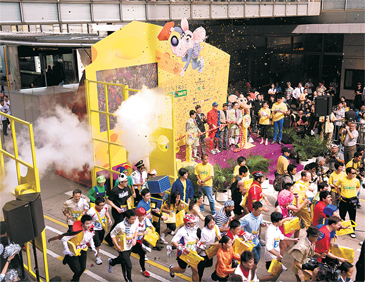
Hongkong Land Ltd.'s Central Rat Race began as costumed racers made their way through leg one carrying relay batons - or in this case, yellow briefcases. |
The company began formulating its strategy when it decided the event should tap into the uniquely ultra-competitive work culture of Hong Kong. Just how competitive is it? Even though the city of 7 million people has been a Special Administrative
Region (SAR) of the communist People's Republic of China since 1997, Hong Kong is as capitalist as the game Monopoly. Its citizens are the marathon runners of the work world, toiling an average of more than 2,250 hours per year, according to the United Nations' International Labour Organization. In fact, Hong Kong's workaholic norm is almost 21 percent above Americans' slacker-like 1,792 annual hours of labor.
So how do you encourage event attendance among a demographic for whom interfering with their work is like getting between a hungry Doberman and his food bowl? Hongkong Land's solution to that peculiar problem possessed the genius of sheer simplicity: Challenge them to compete against each other like Spartacus in
the Coliseum. The company decided to
transform the event into a competitive
fundraising effort for the Hong Kong-located mental-health charity Mindset. It was irresistible bait, even for an audience that takes work as seriously as the Ten Commandments. It was also a shrewd move by a company that grasped the power of philanthropy.
The Cone Cause Evolution Study, compiled by the Boston-based consulting firm Cone LLC, found that 83 percent of people want more of the products or services they use to benefit causes, while 85 percent form a more positive image of a company when it supports a cause they care about. Even more impressive was the study's finding that 80 percent of people are likely to switch brands from one that doesn't support a cause to one that does. Thus, not only would Hongkong Land's charitable challenge likely boost event attendance; it could also reward the company with a philanthropic - and ultimately profitable - image. What's more, it would generate a
genus of publicity few traditional events could match.

On Your Marks .
With the general strategy of the event determined, Hongkong Land now needed to define its style. Given the strategy's emphasis on work and competition, tenets that are as natural to the company and Hong Kong as they are to NCAA March Madness basketball teams, Hongkong Land realized that a Rat Race might be the perfect concept for the event.
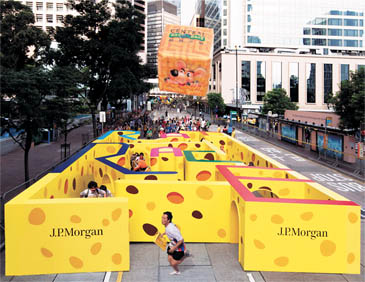
Racers zigzagged through the Job Maze, a 43-by-30-foot maze featuring sponsor logos and cheese-like graphics. |
First recorded in 1783, the term "rat race" described hundreds of vermin frantically crawling and climbing over each other in a meaningless effort to escape from a maze built for the amusement of others. By the 1940s, the term had come to mean modern man's pointless existence as office drones laboring ceaselessly for the profit of others. Then in 1988, the first Rat Race event appeared in New York. Called the Wall Street Rat Race, contestants in workday wear of suits and skirts tore through a 2.5-mile-long stretch of the city's financial district for charity. Since then, these rodent-themed competitions have become a popular fixture in Tokyo; Toronto; Edinburgh, Scotland; and Kuala
Lumpur, Malaysia.
Like Hong Kong, these cities are all renowned for their financial and real-estate industries, and equally extolled for their worker-ant ethic. Just as the work day is now cloned in these centers of commerce (basically 24/7 until some management guru figures out how to squeeze more hours out of it) so too was the anatomy of the Rat Races. In each, business executives or at least generally white-collar workers, often dressed in their best Brooks Brothers attire, raise money for charity by scrambling through a series of physical hindrances arrayed over an outdoor obstacle course. Situated near the cathedrals of commerce like the New York Stock Exchange, the races mock these institutions like a drunken heckler at a comedy club. "It was something the hard-working businesspeople in Hong Kong could easily relate to," says Raymond Chow, Hongkong Land's executive director.
 Dubbing its version the Central Rat Race, the company announced it would launch the event in October of 2006. Keeping with the insurgent humor of other Rat Races, this one would satirize the challenges Hong Kong's executives confront with a
series of tongue-in-cheek obstacles themed on climbing the corporate ladder. But for that alone, all you would need to do is rent a video of "How to Succeed in Business Without Really Trying." Dubbing its version the Central Rat Race, the company announced it would launch the event in October of 2006. Keeping with the insurgent humor of other Rat Races, this one would satirize the challenges Hong Kong's executives confront with a
series of tongue-in-cheek obstacles themed on climbing the corporate ladder. But for that alone, all you would need to do is rent a video of "How to Succeed in Business Without Really Trying."
By structuring it as a relay race benefiting charity, the company was throwing down a gauntlet to competition-crazy attendees they couldn't ignore. Befitting the Hong Kong's "Anything you can do, we can do better" attitude, Hongkong Land also found ingenious ways to expand the concept of the Rat Race and embed its brand as deep as the Marianas Trench into the event's very structure.
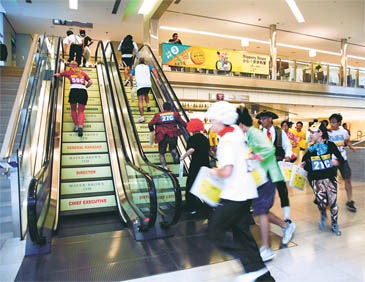
The third leg of the race, called the Corporate Ladder, required participants to scale a set of escalators with various job titles printed on each step. |
But there was another, more subtle layer underneath that of competing
for charity. Mindset's raison d'etre - mental health - echoed the angst over exercise, teamwork, and work-life balance that saturated the airwaves, filled newspapers, and deluged blogs in Hong Kong. Work there consumed lives with the rapaciousness of a wolf pack on a deer. The Rat Race gave those who took part a way of admitting, though with levity and lightness, that overwork can be as fatal as the fang of a rattlesnake.
Aided by Oval Design Ltd., an exhibit- and event-design firm, and event-production company InTech Production, both based in Hong Kong, the company conceived a 1.5-mile-long, multileg course that was to the standard issue Rat Race what the planet Jupiter is to a ping-pong ball. It would run through the heart of the CBD, the ground
zero of Hong Kong's booming $325 billion economy. Each of the race's eight legs would have massive
visual markers, such as 13-foot-tall
inflatable cubes and high-density foam mats shaded the orange-yellow color of aged cheddar cheese.
Cleverly, the company also found a way to permeate the event with its brand by having the contestants sprint through its own properties during various legs of the competition. To make that part a logistical reality, however, it would have to apply to
the government for special permits, as well as hold the event on a Sunday, to minimize the havoc the Rat Race would cause in the normally congested CBD. Hongkong Land
also coordinated with a number of government departments to use all
or part of several streets in the race.
 Relay teams of eight individuals would compete against each other by passing a "baton" - actually, a yellow briefcase that Hongkong Land provided - to other team members as they sped through the different legs of the race. Adding to the visual appeal, competitors would wear a mix of business- and rat-related costume wear, from three-piece suits to Mickey Mouse-style gloves. Relay teams of eight individuals would compete against each other by passing a "baton" - actually, a yellow briefcase that Hongkong Land provided - to other team members as they sped through the different legs of the race. Adding to the visual appeal, competitors would wear a mix of business- and rat-related costume wear, from three-piece suits to Mickey Mouse-style gloves.
In a masterstroke of playing to its audience's dog-eat-dog instincts, Hongkong Land didn't raise the funds for the charity: It made individuals and teams who wanted to take part in the race raise a minimum amount specified for Mindset. To participate in the Rat Race, each team of eight runners had to raise at least $6,500.
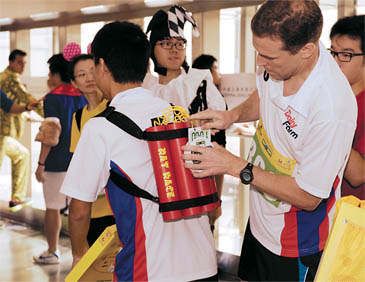
After handing off the briefcase, participants placed "bomb-deactivating cards" into
a timer that "defused" the cardboard bombs strapped to the racers of the fourth leg. |
Mixing press conferences along with television and newspaper
advertisements to promote the event, the company drew attendees from around 40 Hong Kong companies - including corporate heavyweights such as Citigroup Inc. and Mandarin Oriental Hotel Group. That first year, more than 300 people turned out for the inaugural Central Rat Race. The three-hour-long contest raised nearly $260,000 in donations from sponsorships and participating companies
for Mindset. Like jolly court jesters who mocked the strict formality and suffocating social order of corporation-like dynasties from ancient China to Merry Olde England, the races became a good-natured way to remind attendees that nobody on their deathbed ever thought "I wish I had worked more hours."
Just as important, Hongkong Land had formulated a template for the way the event would evolve and thereby flourish over the next few years: play off the extreme Hong Kong worker-bee
mentality; extend its brand by using
its own properties as part of the race-course; persuade the aggressive and ambitious contestants to compete as though it were "The Hunger Games"; and create an objective measure of success through the amount of money raised individually and collectively. Equally as competitive as any of the event's attendees, the company created its own metric for success: the number of attendees, and amount of money raised for Mindset. Increases in both might suggest Hongkong Land had come to occupy a branded niche in the hearts and minds of the Hong Kong business community.
Get Set .
By the sixth iteration of the event in 2011, the Central Rat Race had flown a trajectory NASA might look at with undisguised envy. In just those few years, it had become a venerable local tradition with business executives and nongovernmental organization (NGO) representatives participating as a matter of competitive status and civic goodwill.
Attracting roughly 400 participants each year, the annual event had amassed more than $1.3 million for the charity since its freshman effort in 2006.
With the event's continuing success and growing cachet in Hong Kong, the company would have had every reason to keep the Central Rat Race static, like a board game whose rules and structure are preserved in a kind of procedural amber. Instead, every year Hongkong Land rolled the dice on the tried-and-true formula with the aplomb of Nick the Greek betting his house, introducing new twists to keep the event from becoming as stale as last year's stock prices - and to provide more challenges to pique rivalrous attendees' interest.
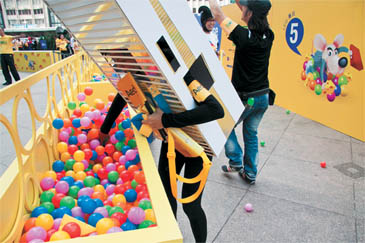
During leg five, dubbed Finding Cheese, racers scrambled to locate pieces of foam cheese in a large bin of colorful plastic balls as quickly as possible. |
It evolved the props from small items to giant inflatable and foam structures such as cubes, slides, and even a fishing pool to make a visual spectacle that looked more like Six Flags Hong Kong than a standard corporate event. It also expanded the event with different competitions, such as the Big Rat Race for senior executives (a shorter course with just two legs for these older honchos), and the Junior Rat Race (also shorter) for children aged five to eight years old. In keeping with the fundraising format implemented for the Rat Race, racers in each of those shorter courses also needed to raise a minimum amount to participate in the event. Over the years, the company developed a number of awards for participants, bestowing accolades such as the Fat Rat Award for the team that raised the most funds, and the Big Rat Cup for the speediest senior executive. Hongkong Land also opened up the event by adding a race just for representatives from NGOs.
Moreover, the company occasionally changed various legs of the race to prevent it from becoming stagnant
and predictable. For example, in 2008, it altered one leg so that runners had to shine shoes - "shoe shining" is a Chinese euphemism for shamelessly sucking up to one's superiors - before passing the footwear on to their teammates. In 2009, with the financial tsunami of the Great Recession still battering the world's financial shores, Hongkong Land themed all eight legs after the economic storm, forcing racers to work through seven sections representing a gloomy present to an eighth and final one representing a bright future.
Each change helped expand the event into a multihour extravaganza that consumed much of Hong Kong's attention the way the Macy's Thanksgiving Day Parade occupies New York's. The net effect of broadening its scope meant not only more participants and therefore more money raised for Mindset, but also a collateral benefit of more media coverage. The larger the radius of the event, the more the local media would cover it, especially since many participants were de facto movers and shakers on the local scene.
 So with the accumulated success of the previous five races under its belt, Hongkong Land was poised to stage the rattiest race ever in 2011. To kick off the preparations, the
company held a press conference in June, a full four months ahead of the event. The conference garnered coverage by local media, including the South China Morning Post, the city's most popular English-language paper, and the TVB Pearl television
station, which is received in 75 percent of Hong Kong homes. While it may seem incongruous to give such a long lead time for an established local event that in 2011 would be entering its sixth iteration, the advance notice was necessary to give participating companies enough leeway to recruit the eight-person teams, decide on what costumes they would wear, and, of course, raise sufficient funds for Mindset to qualify. So with the accumulated success of the previous five races under its belt, Hongkong Land was poised to stage the rattiest race ever in 2011. To kick off the preparations, the
company held a press conference in June, a full four months ahead of the event. The conference garnered coverage by local media, including the South China Morning Post, the city's most popular English-language paper, and the TVB Pearl television
station, which is received in 75 percent of Hong Kong homes. While it may seem incongruous to give such a long lead time for an established local event that in 2011 would be entering its sixth iteration, the advance notice was necessary to give participating companies enough leeway to recruit the eight-person teams, decide on what costumes they would wear, and, of course, raise sufficient funds for Mindset to qualify.
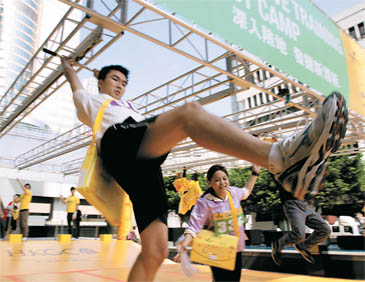
Attendees rode a zip line to the base of a slide in leg six, called Executive Training Boot Camp. Once at the bottom of the slide, they clambored up, briefcases in hand. |
While it created a Facebook page to build buzz, Hongkong Land also relied on more traditional means to generate awareness for the event. For example, it printed 5,000 leaflets that it subsequently placed in what it calls its Central Portfolio, a group of its
12 prestigious and heavily trafficked buildings in the CBD. Additionally, the company took out ads promoting the race in major Chinese-language daily papers such as Oriental Daily, Sing Tao Daily, and the Hong Kong Economic Times, papers boasting a combined readership of approximately 2 million, roughly 29 percent of the entire Hong Kong populace.
Hongkong Land also advertised the event on the Chinese-language television network TVB Jade, TVB Pearl's sister station. "This approach was all part of an effort to capture the attention of the businesspersons we wanted to attract," Chow says. "These publications and television stations are the media outlets that they read and listen to."
Over the next
four months,
the company
readied itself
for the event while the would-be attendees registered for the race, raised the necessary money to qualify, and got ready to rumble.
Go, Rats, Go!
On a bright Sunday morning last October, more than 50 people stood fidgeting inside a yellow inflatable rat cage in downtown Hong Kong. After months of preparing for the race, the big day had finally arrived for the contestants and the company alike. Representing their respective corporations, the imprisoned assemblage waited for the 2011 Central Rat Race's main contest to begin. Several were dressed like Lego characters while others had donned green leotard-like outfits that made them resemble stalks of celery with running shoes. A few costumed themselves as Popeye and his anorexic significant other Olive Oyl; a few came decked out like Dracula. All held yellow briefcases that would function as the relay race's batons. What awaited them outside their cage was a yellow-tinted playground peppered with various props. In the prior 24 hours, a brigade of 400 staffers and volunteers hailing from Hongkong Land, NGOs, and the St. John's Ambulance service had metamorphosed a swathe of the city's CBD. The impromptu army set up approximately 3,000 inflatable and foam props, from walls and slides to platforms and giant wedges of cheese over the course's legs, which in turn were situated next to Hongkong Land's properties.
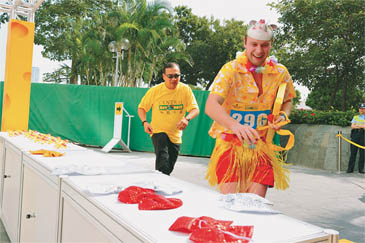
The seventh leg of the race, called Corporate Face, found the costumed racers
donning novelty glasses and a bow tie, then grabbing a newspaper and coffee
mug to keep in hand as they sprinted to the next leg. |
When a starting air horn blared, the first leg began. Dubbed Fast Track, it was set in the shadow of Chater House, the company's 30-story
shopping mecca and office building. The 50-plus racers exploded out of their cheesy cage as if they had
just been told their pension plans
had collapsed. They
sprinted toward leg
two of the race, titled
Job Maze.
Once there, the
attendees hurtled
through a giant 43-by-
30-foot maze, then
handed off the yellow briefcases to their respective cohorts. The next wave rushed to leg three, dubbed Corporate Ladder, near Prince's Building, another upscale company property.  Here they scurried up escalators like firemen at a four-alarm blaze, then zipped around like cast members in an episode of "24," frantically trying to locate eight "bomb-deactivating cards" hidden inside Alexandra House. After they found the cards, they sprinted back to Chater House to meet up with the participants of leg four: Managing the Crisis. They inserted the cards into a timer that "defused" the cartoon-like, cardboard bombs strapped to the leg-four racers. Here they scurried up escalators like firemen at a four-alarm blaze, then zipped around like cast members in an episode of "24," frantically trying to locate eight "bomb-deactivating cards" hidden inside Alexandra House. After they found the cards, they sprinted back to Chater House to meet up with the participants of leg four: Managing the Crisis. They inserted the cards into a timer that "defused" the cartoon-like, cardboard bombs strapped to the leg-four racers.
Carting their defused bombs in hand like Wile E. Coyote, these leg-four racers ran along a pedestrian walkway toward the Open Plaza at Exchange Square, yet another company property. Here in the outdoor commons for leg five, called Finding Cheese, participants scrambled to find three large wedges of foam cheese in different colors, and then run with them to The Rotunda inside Exchange Square, where they fitted the chunks together. This allowed leg six - Executive Training Boot Camp - contestants to take off. They darted like meteors from The Rotunda to Jardine House and leapt onto a zip line, which whisked them to the base of a slide. The racers had to clamber up the slide with their briefcases, then zoom down before they could pass them on to the next group for leg seven, Corporate Face. Donning novelty glasses and a bow tie, then picking up a newspaper and a coffee mug, this group zoomed over the pedestrian footbridge leading back to Chater House. Once there, they sprinted down Ice House Street to the Mandarin Oriental Hong Kong Hotel to meet up with their counterparts for the eighth and final leg, labeled Dash-to-Cash.
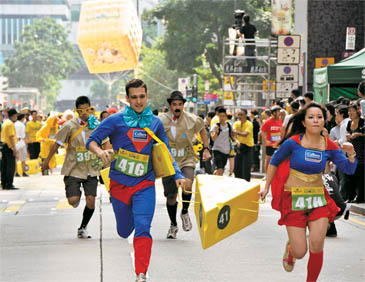
Racers teamed up to carry a giant hunk of faux cheddar down Chater Road to the finish line as spectators cheered them on. |
Now, in the last few hurried minutes of the race, legs seven and eight members had to work together to heft a giant hunk of faux cheese down Chater Road to the finish line near Alexandra House, close to where the race had begun just 10 minutes ago. When the winning team - real-estate services firm CB Richard Ellis Ltd. - waddled in under their burden of cheese, the throng of onlookers erupted in applause for the victors, who were dressed in yellow-and-green patterned outfits that suggested a leprechaun on acid.
While the eight-leg Rat Race was the main focus of the event, the other competitions - for senior executives, children, and NGO reps - took place amid the hundreds of spectators who cheered them, and media representatives who recorded them. Following the contests, the company presented awards to the winners in 16 various categories, including not just the winners of each competition, the biggest fundraisers, and the best costumes, but the company with the most enthusiastic cheerleading teams as well.
Despite the Central Rat Race's emphasis on cutthroat competition and one-upping your rivals - delivered with a sly wink - Hongkong Land treated the event with the who-cares-about-the-score attitude of T-ball. Besides admitting that it received a generic "many" media impressions for the event, the company points with pride to the metrics it cares about most: attendance and the amount of money raised. The number of attendees for 2011 surged by 12.5 percent over 2010. Most significantly, the amount of  money raised for Mindset increased almost 8 percent, from about $313,000 in 2010 to nearly $337,000, the most the event has ever totaled, and nearly double the $171,000 it accrued in recession-wracked 2009. money raised for Mindset increased almost 8 percent, from about $313,000 in 2010 to nearly $337,000, the most the event has ever totaled, and nearly double the $171,000 it accrued in recession-wracked 2009.
By establishing its brand through an event that incorporated its own properties, and raising hundreds of thousands in charitable donations by playing on the psychology of attendees. Hongkong Land connected to something deeper in its audience beyond the comic costumes and the preposterous props. Perhaps the Rat Race was just a "frail enchantment," a temporary respite from the grind that never relents. The attendees would soon return to work, but perhaps their burden might be lightened by the knowledge that you don't have to be
a rat to win a rat race. E
|




 n the television show "Mad Men," work is something you do between sipping scotch and seducing secretaries. But in real life, work is a strenuous race of indeterminate length and ever-changing obstacles. Work is a Sisyphean boulder that must be rolled back up a hill of Mount Everest proportions each and every day. Its battlefields are the boardrooms, and its weapons are forged in the foundries of Office Depot Inc. and Microsoft Corp. It was this world of 24/7 workers that Hongkong Land Ltd. acknowledged with an event that EXHIBITOR Magazine's Corporate Event Awards judges hailed as "an exemplary interactive experience."
n the television show "Mad Men," work is something you do between sipping scotch and seducing secretaries. But in real life, work is a strenuous race of indeterminate length and ever-changing obstacles. Work is a Sisyphean boulder that must be rolled back up a hill of Mount Everest proportions each and every day. Its battlefields are the boardrooms, and its weapons are forged in the foundries of Office Depot Inc. and Microsoft Corp. It was this world of 24/7 workers that Hongkong Land Ltd. acknowledged with an event that EXHIBITOR Magazine's Corporate Event Awards judges hailed as "an exemplary interactive experience."  Headquartered in Hong Kong, the company is one of Asia's oldest property-investment, management, and development firms. Founded in 1889, Hongkong Land grew, as Hong Kong did, from a backwater nonentity to an economic empire. Today, the company with $1.2 billion in 2011 revenue rules a sphere of real-estate interests as gilded as the Doge's Palace in Venice, with major properties in locales ranging from Singapore and The Philippines to Vietnam and mainland China.
Headquartered in Hong Kong, the company is one of Asia's oldest property-investment, management, and development firms. Founded in 1889, Hongkong Land grew, as Hong Kong did, from a backwater nonentity to an economic empire. Today, the company with $1.2 billion in 2011 revenue rules a sphere of real-estate interests as gilded as the Doge's Palace in Venice, with major properties in locales ranging from Singapore and The Philippines to Vietnam and mainland China. 


 Dubbing its version the Central Rat Race, the company announced it would launch the event in October of 2006. Keeping with the insurgent humor of other Rat Races, this one would satirize the challenges Hong Kong's executives confront with a
series of tongue-in-cheek obstacles themed on climbing the corporate ladder. But for that alone, all you would need to do is rent a video of "How to Succeed in Business Without Really Trying."
Dubbing its version the Central Rat Race, the company announced it would launch the event in October of 2006. Keeping with the insurgent humor of other Rat Races, this one would satirize the challenges Hong Kong's executives confront with a
series of tongue-in-cheek obstacles themed on climbing the corporate ladder. But for that alone, all you would need to do is rent a video of "How to Succeed in Business Without Really Trying." 
 Relay teams of eight individuals would compete against each other by passing a "baton" - actually, a yellow briefcase that Hongkong Land provided - to other team members as they sped through the different legs of the race. Adding to the visual appeal, competitors would wear a mix of business- and rat-related costume wear, from three-piece suits to Mickey Mouse-style gloves.
Relay teams of eight individuals would compete against each other by passing a "baton" - actually, a yellow briefcase that Hongkong Land provided - to other team members as they sped through the different legs of the race. Adding to the visual appeal, competitors would wear a mix of business- and rat-related costume wear, from three-piece suits to Mickey Mouse-style gloves. 

 So with the accumulated success of the previous five races under its belt, Hongkong Land was poised to stage the rattiest race ever in 2011. To kick off the preparations, the
company held a press conference in June, a full four months ahead of the event. The conference garnered coverage by local media, including the South China Morning Post, the city's most popular English-language paper, and the TVB Pearl television
station, which is received in 75 percent of Hong Kong homes. While it may seem incongruous to give such a long lead time for an established local event that in 2011 would be entering its sixth iteration, the advance notice was necessary to give participating companies enough leeway to recruit the eight-person teams, decide on what costumes they would wear, and, of course, raise sufficient funds for Mindset to qualify.
So with the accumulated success of the previous five races under its belt, Hongkong Land was poised to stage the rattiest race ever in 2011. To kick off the preparations, the
company held a press conference in June, a full four months ahead of the event. The conference garnered coverage by local media, including the South China Morning Post, the city's most popular English-language paper, and the TVB Pearl television
station, which is received in 75 percent of Hong Kong homes. While it may seem incongruous to give such a long lead time for an established local event that in 2011 would be entering its sixth iteration, the advance notice was necessary to give participating companies enough leeway to recruit the eight-person teams, decide on what costumes they would wear, and, of course, raise sufficient funds for Mindset to qualify. 

 Here they scurried up escalators like firemen at a four-alarm blaze, then zipped around like cast members in an episode of "24," frantically trying to locate eight "bomb-deactivating cards" hidden inside Alexandra House. After they found the cards, they sprinted back to Chater House to meet up with the participants of leg four: Managing the Crisis. They inserted the cards into a timer that "defused" the cartoon-like, cardboard bombs strapped to the leg-four racers.
Here they scurried up escalators like firemen at a four-alarm blaze, then zipped around like cast members in an episode of "24," frantically trying to locate eight "bomb-deactivating cards" hidden inside Alexandra House. After they found the cards, they sprinted back to Chater House to meet up with the participants of leg four: Managing the Crisis. They inserted the cards into a timer that "defused" the cartoon-like, cardboard bombs strapped to the leg-four racers. 
 money raised for Mindset increased almost 8 percent, from about $313,000 in 2010 to nearly $337,000, the most the event has ever totaled, and nearly double the $171,000 it accrued in recession-wracked 2009.
money raised for Mindset increased almost 8 percent, from about $313,000 in 2010 to nearly $337,000, the most the event has ever totaled, and nearly double the $171,000 it accrued in recession-wracked 2009. 


